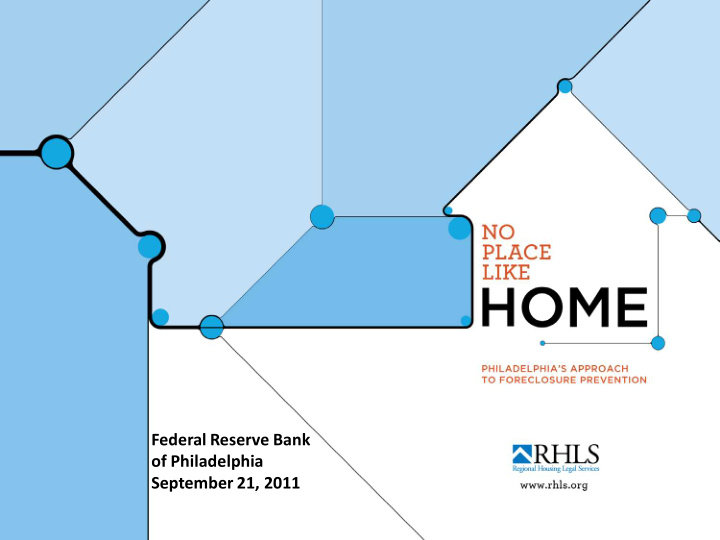



Federal Reserve Bank of Philadelphia September 21, 2011
Philadelphia Foreclosure Prevention Approach: How It Works • Interviewed over 60 stakeholders in 2010 and 2011 • Quantitative study by The Reinvestment Fund • Two primary programs : HEMAP and Diversion Program – Home Affordable Modification Program (HAMP) Emergency Homeowners’ Loan Program (EHLP) Litigation continued • Housing counselors as lynchpin
Philadelphia’s Pre-2008 Home Foreclosure-Prevention Process
Philadelphia Foreclosure Prevention Approach: How It Works 1. Identify at-risk homeowners (Act 91 Notice) 2. Perform outreach (Neighborhood Advisory Comm) 3. Hotline (Philadelphia Legal Assistance) 4. Create budget and workout proposal (Counselors) 5. Apply to relevant State and Federal programs (Counselors) 6. Refer homeowner to lawyer (Counselors) 7. Negotiate at Conciliation Conference (Counselors/Lawyers)
Philadelphia’s Current Home Foreclosure-Prevention Process
8 Priority Recommendations • HEMAP and Diversion Program are national best practices • Today Philadelphia remains on the front lines looking for ways to refine and improve its strategy • Yet funding to help at risk homeowners is being cut at the State and Federal level
1. Offer Alternative Paths to Assistance High Medical Bills Medical Insurance Seniors Benefits Homeowners 49 Existing Programs Study found medical causes contribute to 1 in 4 Philadelphia foreclosures and medical costs are the primary cause of 1 in 10 foreclosures.
At-Risk Homeowners and Seniors
1. Progress to Date and Next Steps P rogress To Date • List Of 49 Existing Programs Compiled • RHLS And Health Law Project Pilot (On Hold) • Benefits Data Trust Working With Court N ext Steps • Post List Online In Single Location • Create Uniform Application and Process
2. Provide Housing Counselors with Training, Certification and Standards • Housing counselor experience and skills vary • 31 small counseling agencies • Counselors define client’s options • Trainings twice a year – Can perform without training for up to six months • 73% of HUD counselors support need for national standards
2. Progress to Date and Next Steps P rogress to Date • Training & Supervision Strengthened • Testing and Certification Required N ext Steps • Hold Counselors to Professional Standards • Inform Client of All Alternatives and Provide Written Action Plan • Provide Better First Line Supervision • Create 2 Tiers of Counselors
3. Ensure All Eligible Homeowners Apply to HEMAP or EHLP • Application rates varied greatly
3. Progress to Date and Next Steps P rogress to Date • Counselors Will Receive PHFA Training • Courts Make Computer Available For Applications • Outreach Re EHLP N ext Steps • Monitor Each Counselors HEMAP/EHLP Applications • Restore HEMAP Funding
4. Better Coordinate City and State Counselors • Require separate multi-day trainings • Only State-funded counselors compensated for HEMAP applications • Only City-funded counselors can bring clients to Diversion Court • Data entry duplicative and limited
4. Progress to Date and Next Steps P rogress to Date • Training Coordinated N ext Steps • Integrate Counselor Networks • Compensate City Counselors for HEMAP applications • Allow State Counselors Into Diversion Court • Jointly Adopt One Database
5. Improve Lawyer/Counselor Relationship. Clarify Referral and Case Selection Criteria
5. Progress to Date and Next Steps P rogress to Date • Early Discussions Held N ext Steps • Convene Lawyers And Counselors • Create Standards For Referrals • Share Standards For Case-Selection • Create Information Sharing Agreement
6. Improve Data Collection
6. Progress to Date and Next Steps P rogress to Date • TRF Study Significant – Analysis Needs to Continue • New Court Order Form Provides Better Data • Discussions Re Keeping Stakeholders Updated N ext Steps • Update Data With Actions And Outcomes • PLA And CLS Invest In New Technology • Provide Online Resource For Homeowners • Sheriff’s Office Keeps And Shares Accurate Data
7. Gain Cooperation of Sheriff • Millions of dollars of homeowners’ money not returned • $1700 fee charged to homeowner • Database inaccurate • Data not shared • Require stays to be hand-delivered
7. Progress to Date and Next Steps P rogress to Date • MOUs To Increase Cooperation and Access To Data N ext Steps • Return All Sales Proceeds To Homeowners • Reduce $1700 Fee • Stay Foreclosures With Electronic Order • Update And Share Database • Provide Writs To Court In Timely Manner
8. Continue to Fund Efforts
8. Progress to Date and Next Steps P rogress to Date • Philadelphia Has Made Foreclosure Prevention Effective Through Generous Funding of $3 million a year N ext Steps • State Must Re-Allocate HEMAP Funding • Implement Reforms • City Should Continue to Fund Until Foreclosure Rates Drop Back to 2006 Levels
8. Model for Other Cities Replicable and Scalable Where: • Judicial Foreclosure State • Ability to Identify at Risk Homeowners • Substantial Counselor Capacity • Strong Leadership
Federal Reserve Bank of Philadelphia September 21, 2011
Recommend
More recommend